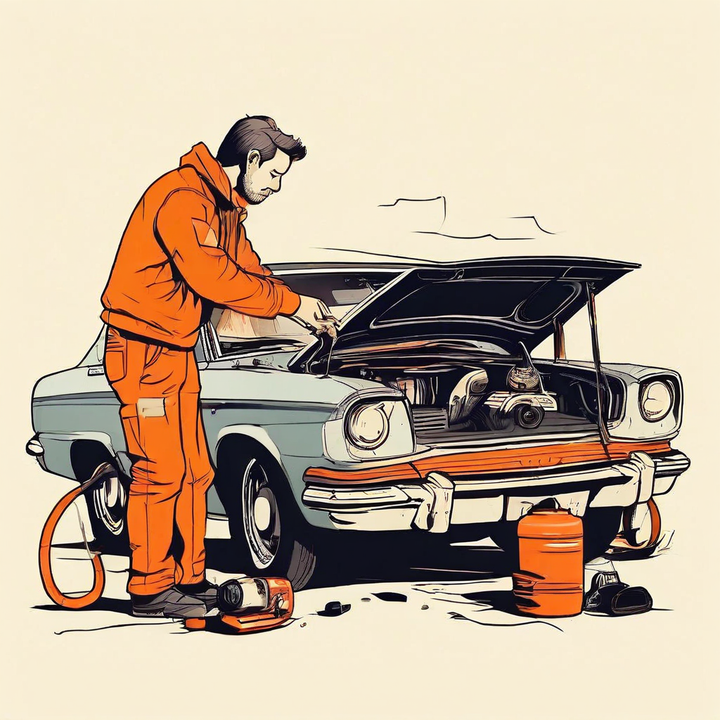


Experiencing your car dying or stalling when you press the gas pedal can be a frustrating and potentially dangerous situation. This issue can occur due to various reasons, ranging from simple maintenance issues to more complex mechanical problems. Understanding the underlying causes is crucial to addressing the problem effectively and ensuring a smooth and safe driving experience.

But fear not, my fellow drivers! In this article, I'll share my expertise and walk you through the most common causes of this problem, as well as the diagnostic steps and repair solutions. By the end, you'll have a better understanding of what might be causing your car to die when you hit the accelerator, and you'll be equipped with the knowledge to tackle the issue head-on.
Before we dive into the nitty-gritty details, let's take a look at the main suspects that could be causing your car to die when you give it gas:
| Potential Causes |
|---|
| Fuel System Issues |
| Air and Exhaust System Problems |
| Ignition System Faults |
| Sensor and Electronic Issues |
| Vacuum Leaks |
The fuel system is the lifeblood of your engine, and any hiccups in this area can lead to serious problems. Common culprits include:
Clogged or faulty fuel filter
Malfunctioning fuel pump or low fuel pressure
Faulty fuel injectors
Issues with the fuel pressure regulator
Your engine needs a precise balance of air and fuel to run smoothly. If there's a problem with the air intake or exhaust system, it can throw off this delicate balance and cause your car to stall or die when you hit the gas. Potential issues include:
Clogged air filter
Faulty mass airflow (MAF) sensor
Stuck open or faulty exhaust gas recirculation (EGR) valve
The ignition system is responsible for providing the spark that ignites the air-fuel mixture in your engine's cylinders. If this system is compromised, it can lead to misfires and stalling. A common culprit here is worn out or fouled spark plugs.

Modern cars are equipped with a plethora of sensors and electronic components that work together to ensure optimal engine performance. If any of these components malfunction, it can cause your car to die when you give it gas. Potential issues include:
Faulty throttle position sensor (TPS)
Malfunctioning engine control unit (ECU)
Wiring issues and broken connections
Vacuum leaks might seem like a minor issue, but they can have a significant impact on your engine's performance. Leaks in the vacuum system can cause a lean air-fuel mixture, which can lead to stalling or dying when you hit the gas.
Now that we've identified the potential culprits, let's dive into the diagnostic steps you or your mechanic can take to pinpoint the root cause of the problem:
Check the fuel pressure when the engine is running and monitor if it drops when giving gas. Low pressure indicates a fuel pump or regulator issue.
Inspect the air filter and MAF sensor for clogs or contamination.
Check for vacuum leaks by monitoring the idle speed when disconnecting vacuum hoses like the brake booster line.
Examine spark plugs for wear or fouling, which can indicate rich or lean conditions.
Use an OBD2 scanner to check for diagnostic trouble codes related to sensors like TPS, MAF, or fuel system components.
Test electrical connections and wiring harnesses for breaks or corrosion.
Once you've identified the root cause of the problem, it's time to roll up your sleeves (or take it to a professional) and get to work on the repairs:
| Repair Category | Solutions |
|---|---|
| Fuel System | - Replace clogged fuel filter - Check and replace faulty fuel pump if needed - Clean or replace faulty fuel injectors - Replace fuel pressure regulator if defective |
| Air and Exhaust System | - Replace clogged air filter - Clean or replace MAF sensor - Clean or replace stuck open EGR valve |
| Ignition System | - Replace worn out or fouled spark plugs |
| Sensors and Electronics | - Replace faulty TPS - Diagnose and repair wiring issues or replace damaged wiring harnesses - As a last resort, replace the ECU if it is malfunctioning |
| Vacuum Leaks | - Locate and repair vacuum leaks, replacing any damaged vacuum lines or components |
While repairs can be costly, prevention is often the best medicine. Here are some tips to help you avoid the frustration of your car dying when you give it gas:
Follow the manufacturer's recommended maintenance schedule for replacing air filters, spark plugs, and other wear items.
Use high-quality fuel and keep the fuel system clean with additives.
Inspect vacuum hoses and wiring harnesses regularly for any signs of damage or deterioration.
Have your vehicle's computer systems and sensors diagnosed regularly by a professional mechanic.
Let's be real, car repairs can put a dent in your wallet. The cost of repairs can vary significantly depending on the specific issue and the make/model of your vehicle. Here are some common repair costs to give you an idea:
| Repair | Cost Range |
|---|---|
| Fuel filter replacement | $20 - $100 |
| Fuel pump replacement | $300 - $1000 |
| Fuel injector replacement | $200 - $800 per injector |
| Spark plug replacement | $50 - $200 |
| Sensor replacement (MAF, TPS, etc.) | $100 - $400 |
| ECU replacement | $500 - $1500 |
My advice? Have a professional mechanic diagnose the issue accurately before attempting any repairs. This will help you avoid unnecessary costs and ensure that the root cause is addressed correctly. And remember, regular maintenance can help prevent costly breakdowns in the long run.
Dealing with a car that dies when you give it gas can be a frustrating and stressful experience. But with the right knowledge and approach, you can tackle this issue head-on and get back on the road with confidence.
Remember, prevention is key. By following the recommended maintenance schedule and keeping an eye out for any potential issues, you can minimize the chances of encountering this problem in the first place.
And if you do find yourself in this situation, don't panic. Follow the diagnostic steps, identify the root cause, and take the necessary repair actions. With a little patience and perseverance, you'll have your trusty ride running smoothly again in no time.
So, keep your chin up, my fellow drivers! With the right mindset and a little elbow grease, you can conquer any automotive challenge that comes your way.
Common signs include the engine sputtering, stalling, or losing power when accelerating. The check engine light may also illuminate on the dashboard.
You can diagnose a vacuum leak by monitoring the idle speed while disconnecting vacuum hoses like the brake booster line. An unstable or fluctuating idle could indicate a leak.
The MAF sensor measures the amount of air entering the engine, allowing the computer to adjust the fuel delivery for optimal air-fuel ratio.
Worn or fouled spark plugs can cause misfires and incomplete combustion, leading to poor engine performance and potential stalling when accelerating.
The TPS monitors the position of the throttle valve and relays this information to the engine control unit (ECU) to adjust the air-fuel mixture accordingly.
Yes, a faulty fuel pressure regulator can cause inconsistent fuel pressure, leading to lean or rich air-fuel mixtures and potential stalling or dying when accelerating.
Using high-quality fuel can help prevent buildup and contamination in the fuel system, which can lead to issues like clogged injectors or filters.
The EGR valve recirculates a portion of the exhaust gases back into the engine's intake system, reducing the formation of harmful nitrogen oxides (NOx) emissions.
Yes, wiring issues or broken connections can disrupt the communication between sensors and the ECU, leading to improper air-fuel mixture calculations and potential stalling.
Regular maintenance, such as replacing air filters, spark plugs, and checking for vacuum leaks, can help identify and address potential issues before they lead to more significant problems like stalling or dying when accelerating.

Sarah isn't your average gearhead. With a double major in Mechanical Engineering and Automotive Technology, she dived straight into the world of car repair. After 15 years of turning wrenches at dealerships and independent shops, Sarah joined MICDOT to share her expertise and passion for making cars run like new. Her in-depth knowledge and knack for explaining complex issues in simple terms make her a valuable asset to our team.













